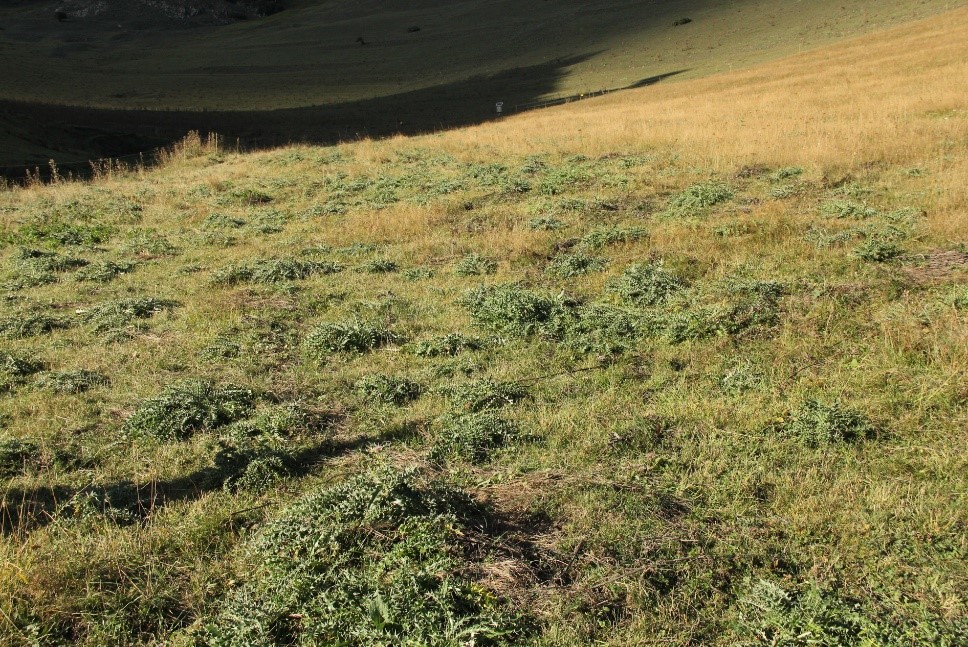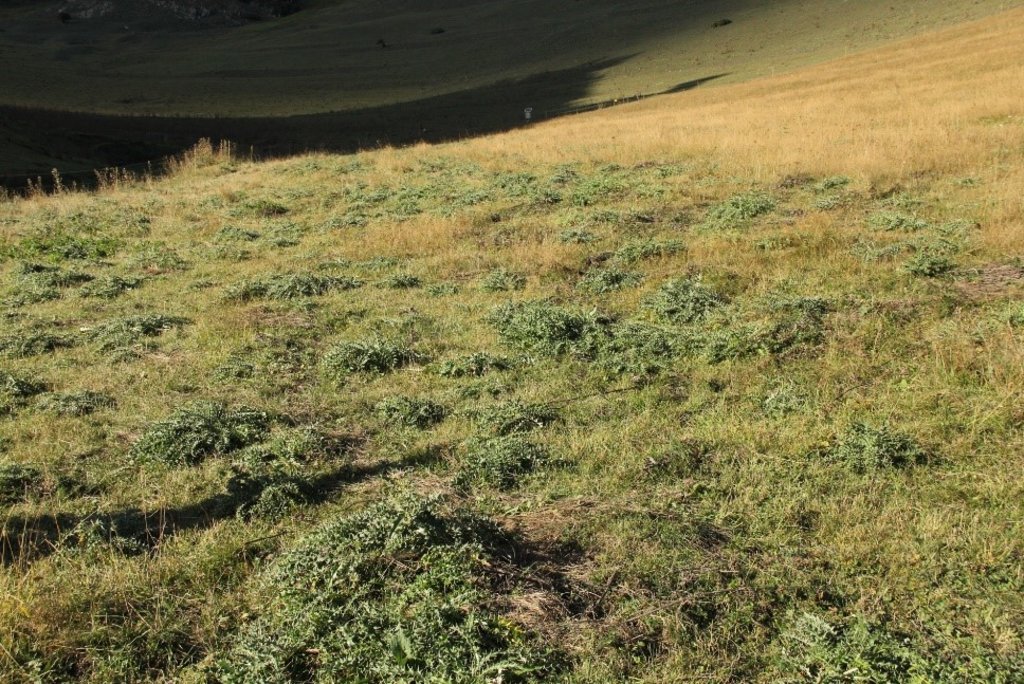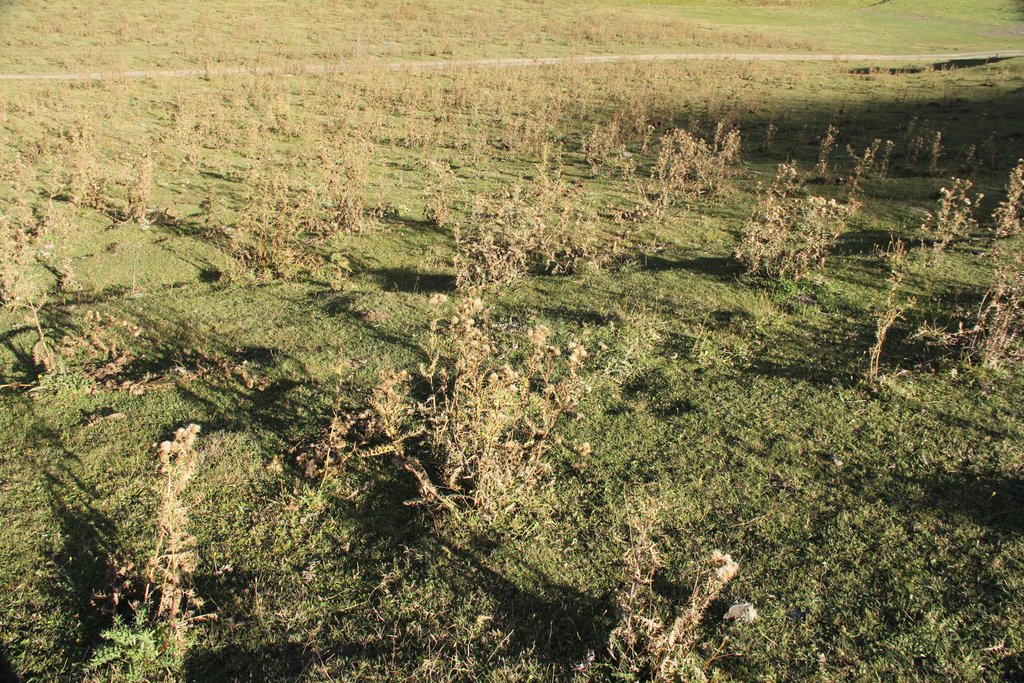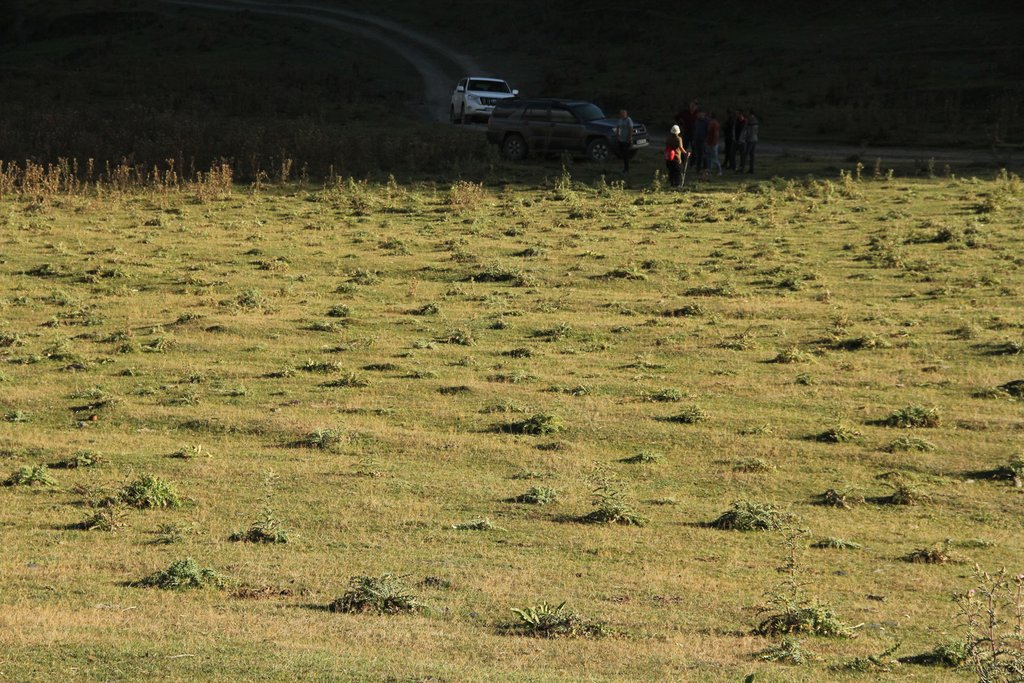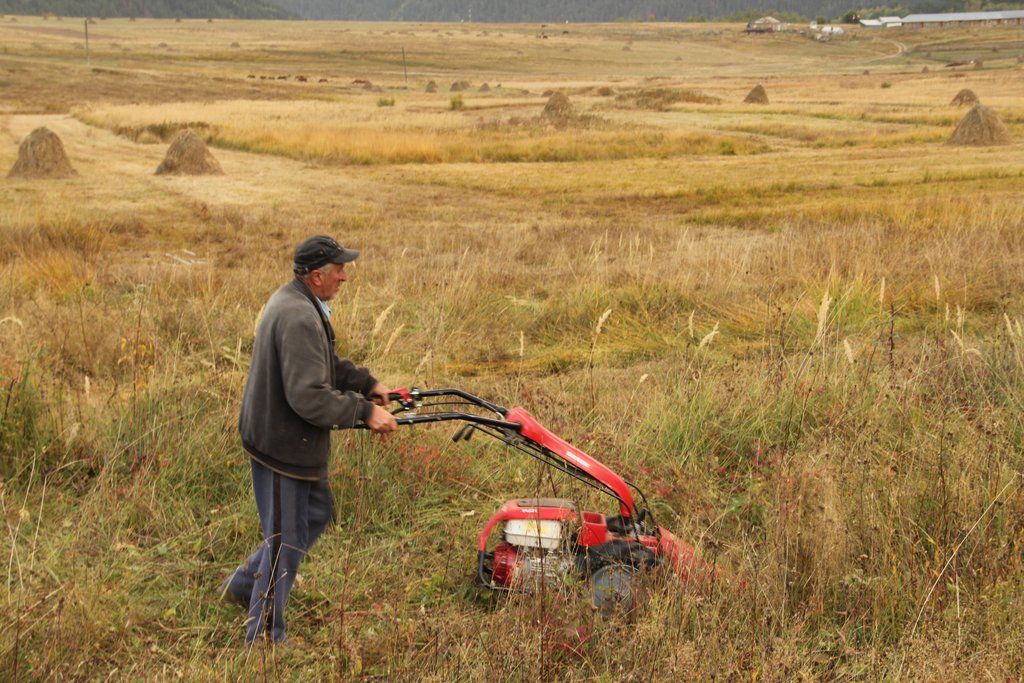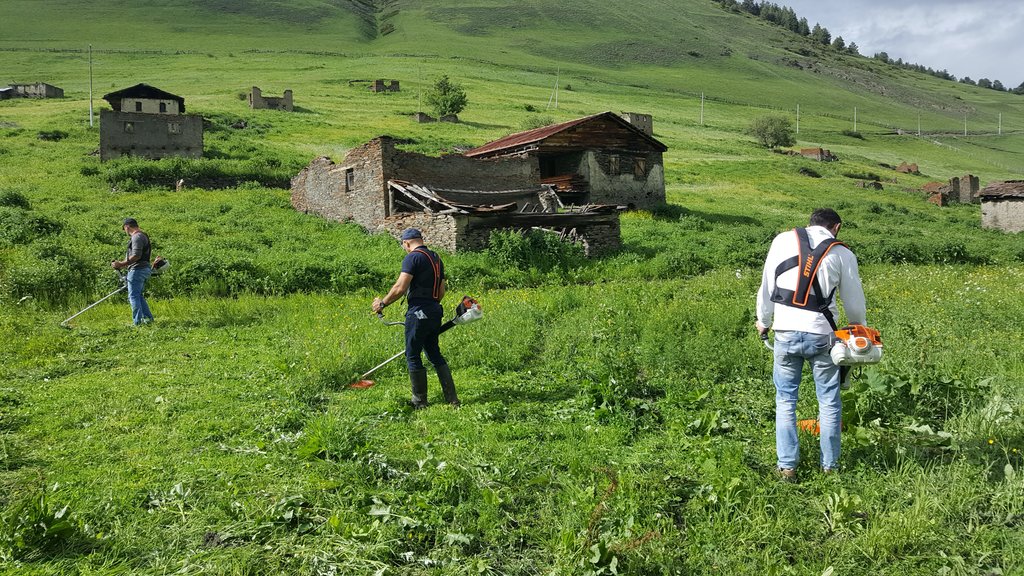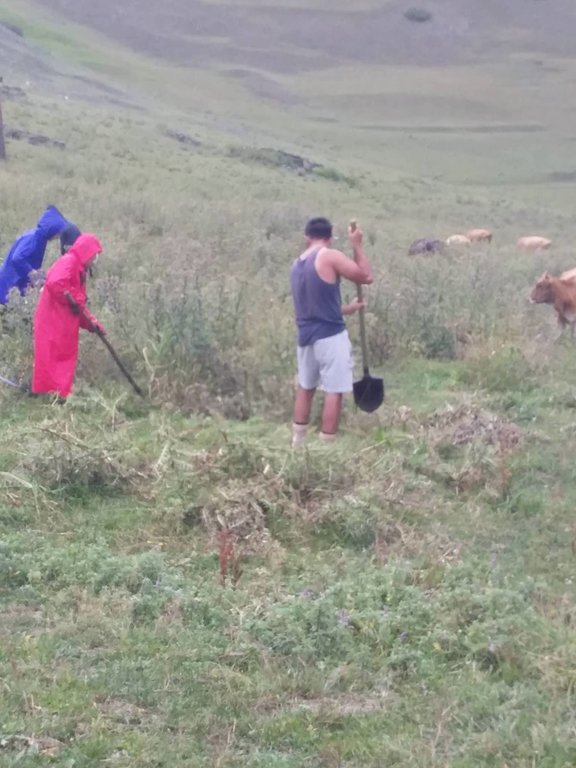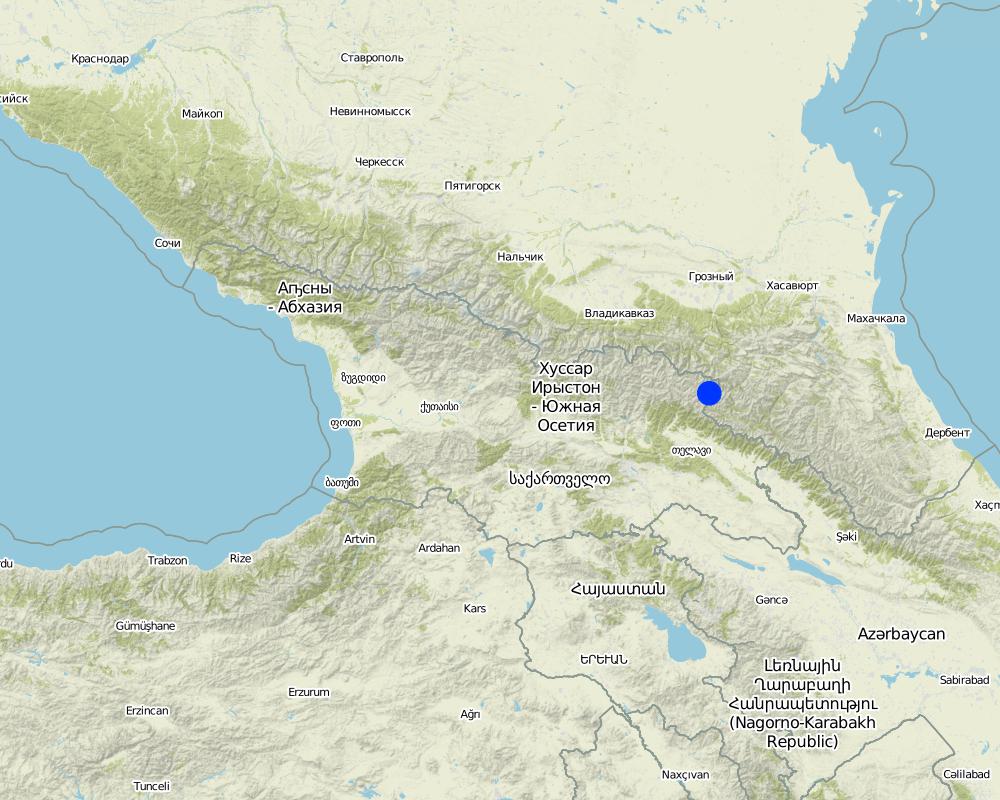Pasture-weed control by thistle cutting [Georgia]
- Creation:
- Update:
- Compiler: Hanns Kirchmeir
- Editor: Kety Tsereteli
- Reviewer: Ursula Gaemperli
technologies_4273 - Georgia
View sections
Expand all Collapse all1. General information
1.2 Contact details of resource persons and institutions involved in the assessment and documentation of the Technology
Key resource person(s)
SLM specialist:
co-compiler:
1.3 Conditions regarding the use of data documented through WOCAT
The compiler and key resource person(s) accept the conditions regarding the use of data documented through WOCAT:
Yes
1.4 Declaration on sustainability of the described Technology
Is the Technology described here problematic with regard to land degradation, so that it cannot be declared a sustainable land management technology?
No
Comments:
The applied technology avoids the application of chemicals by mechanical weed removal.
1.5 Reference to Questionnaire(s) on SLM Approaches (documented using WOCAT)
2. Description of the SLM Technology
2.1 Short description of the Technology
Definition of the Technology:
Thistles invaded massively into village pasture land at 1800m elevation in the Caucasus. By cutting the thistles with a motor-cutter the cover of thistles have been reduced.
2.2 Detailed description of the Technology
Description:
The technology was applied in flat sub-alpine pasture land at an elevation of about 1800 m in the village of Shenako in the Tusheti Protected Landscape, Georgia. Precipitation is 750-900mm and mean annual temperature is 2-4°C. Thistles (Cirsium sp.) were invading especially in those sections of the pasture that are rich in nutrients and have medium soil water content. This site conditions can be found mainly at the valley bottom.
There are no big machines available in this mountain villages. So the removal was done by motor-cutters. In this particular case STIHL petrol brush cutters were used with a 3 blade bush knife.
The removal of the thistles, which were covering up to 20% of the pasture land will increase the productivity of valuable fodder grass and herbs. The thistles are growing up to 1m height and taking up significant amount of nutrients from the soil and are shading other grass and herbs in their neighborhood. Because of their spices they are not eaten by cows or sheep, while the grazing pressure is increasing on the remaining grass and herb species. This leads to positive selection of thistles and a permanent increase of the thistles number and biomass in comparison to the high quality fodder plants.
The thistles have been cut in mid-June/beginning of July just at the begin of blossom. At this stage, the thistles mobilized most of the nutrients from their root system and spent them in leaf and blossom biomass. By cutting the thistles at this time, the highest impact on the nutrient balance can be reached and no new seeds will be produced in this year. It was observed, that the thistles have been eaten by the livestock when it was cut and dried up.
The motor brush cutter increases significantly the speed of cutting the thistles compared to hand scythe. The thistle has a powerful root system and is re-sprouting from the roots within the same summer. So it is important to repeat the cutting 2-3 times a year and to continue several years until the amount of thistles is permanently reduced.
The reduction of thistles will give more space, nutrients and moisture to other fodder plants and increase the productivity of the pasture land.
The challenge is the coordination of the work load within the users of the community pasture land. It needs a (written) agreement to share the workload for pasture maintenance between the families according to their number of livestock.
2.3 Photos of the Technology
General remarks regarding photos:
The photos are showing the state of the pastures before and 2 months after the application of the technology.
2.4 Videos of the Technology
Comments, short description:
No video available
2.5 Country/ region/ locations where the Technology has been applied and which are covered by this assessment
Country:
Georgia
Region/ State/ Province:
Kakheti
Further specification of location:
Shenako
Specify the spread of the Technology:
- evenly spread over an area
If the Technology is evenly spread over an area, specify area covered (in km2):
0.02
If precise area is not known, indicate approximate area covered:
- < 0.1 km2 (10 ha)
Is/are the technology site(s) located in a permanently protected area?
Yes
If yes, specify:
The village of Shenako is located in the Tusheti Protected Landscape. This category is managed by the Municipality of Akhmeta.
Comments:
The number of families using the village pastureland for their livestock has decreased during the last decades. In former times the 200 ha of open land around the village was used as arable land and hay meadows and the livestock was grazed on remote pastures.
Map
×2.6 Date of implementation
Indicate year of implementation:
2018
2.7 Introduction of the Technology
Specify how the Technology was introduced:
- through projects/ external interventions
Comments (type of project, etc.):
The weed control was funded and applied within a GEF Projected coordinated by REC Caucasus ("Applying Landscape and Sustainable Land Management (L-SLM) for mitigating land degradation and contributing to poverty reduction in rural areas"). It can be assumed, that there have been community based regulation on pasture maintenance before the Soviet period, but this regulations have not been re-established after this period.
3. Classification of the SLM Technology
3.1 Main purpose(s) of the Technology
- improve production
- reduce, prevent, restore land degradation
- create beneficial economic impact
3.2 Current land use type(s) where the Technology is applied
Land use mixed within the same land unit:
No

Grazing land
Extensive grazing:
- Transhumant pastoralism
Animal type:
- cattle - dairy
- horses
- sheep
Is integrated crop-livestock management practiced?
No
Products and services:
- meat
- milk
Species:
cattle - dairy
Count:
70
Species:
sheep
Count:
400
Species:
horses
Count:
30
Species:
cattle - non-dairy beef
Count:
35
Comments:
The area of implementation is community pasture land.
3.3 Has land use changed due to the implementation of the Technology?
Has land use changed due to the implementation of the Technology?
- No (Continue with question 3.4)
3.4 Water supply
Water supply for the land on which the Technology is applied:
- rainfed
3.5 SLM group to which the Technology belongs
- pastoralism and grazing land management
3.6 SLM measures comprising the Technology

management measures
- M5: Control/ change of species composition
Comments:
The technology aims to reduce the amount of thistles in the species composition of the pasture.
3.7 Main types of land degradation addressed by the Technology

biological degradation
- Bs: quality and species composition/ diversity decline
Comments:
The degradation of the pastures is driven by the spreading of thistles. This process leads to a reduction of plant-diversity (shading) and fodder production.
3.8 Prevention, reduction, or restoration of land degradation
Specify the goal of the Technology with regard to land degradation:
- reduce land degradation
Comments:
Cutting thistles is an measure for weed-control and reduces the risk of overgrazing be increasing the available area and amount of fodder plants.
4. Technical specifications, implementation activities, inputs, and costs
4.1 Technical drawing of the Technology
Technical specifications (related to technical drawing):
The activity was applied on two plots. Plot 6 is 0.7 ha of size and located in the unfenced area. Plot 7 is 1.3 ha of size and located inside an electric fence. The hatched area (8) is indicating the fenced area.
Author:
Hanns Kirchmeir
Date:
20/03/2019
4.2 General information regarding the calculation of inputs and costs
Specify how costs and inputs were calculated:
- per Technology area
Indicate size and area unit:
2 ha
Specify currency used for cost calculations:
- USD
4.3 Establishment activities
| Activity | Timing (season) | |
|---|---|---|
| 1. | Prepare machinery and organize people | June |
| 2. | Select pasture plots were the measure will be applied | June |
| 3. | Cut the thistles on the selected pasture plots | End of June - Mid of July |
Comments:
When working with a hand-held brush cutter it is recommended to start in those areas with less thistles and work into the direction of dense thistle stands. When working with a tractor or a sickle bar mower it is more efficient to apply the activity in dens thistle stands.
4.4 Costs and inputs needed for establishment
| Specify input | Unit | Quantity | Costs per Unit | Total costs per input | % of costs borne by land users | |
|---|---|---|---|---|---|---|
| Labour | Selection of sites, preparation of materials and people | person-days | 3.0 | 37.0 | 111.0 | |
| Labour | Labour for cutting thistles on 2 ha | person-days | 10.0 | 20.0 | 200.0 | |
| Equipment | High quality brush cutter | pieces | 1.0 | 800.0 | 800.0 | |
| Equipment | Patrol (20l) and diesel (30l) for brush cutter (6 days, 8h/day, 1l/h) | liter | 50.0 | 1.0 | 50.0 | |
| Total costs for establishment of the Technology | 1161.0 | |||||
| Total costs for establishment of the Technology in USD | 1161.0 | |||||
If land user bore less than 100% of costs, indicate who covered the remaining costs:
The equipment (brush cutters) and labour costs have been carried by international project (GIZ-IBiS Program, GEF funded SML Project)
4.5 Maintenance/ recurrent activities
| Activity | Timing/ frequency | |
|---|---|---|
| 1. | Repeat cutting of thistles 2x per year | June/July and September |
4.6 Costs and inputs needed for maintenance/ recurrent activities (per year)
| Specify input | Unit | Quantity | Costs per Unit | Total costs per input | % of costs borne by land users | |
|---|---|---|---|---|---|---|
| Labour | labour for cutting thistles (2ha) | person-days | 6.0 | 20.0 | 120.0 | 100.0 |
| Equipment | Patrol for brush cutter | liter | 96.0 | 1.0 | 96.0 | |
| Total costs for maintenance of the Technology | 216.0 | |||||
| Total costs for maintenance of the Technology in USD | 216.0 | |||||
Comments:
The ongoing maintenance has to be covered by the local farmers
4.7 Most important factors affecting the costs
Describe the most determinate factors affecting the costs:
The investment in the brush cutter will only pay off if large parts of pastures are managed.
5. Natural and human environment
5.1 Climate
Annual rainfall
- < 250 mm
- 251-500 mm
- 501-750 mm
- 751-1,000 mm
- 1,001-1,500 mm
- 1,501-2,000 mm
- 2,001-3,000 mm
- 3,001-4,000 mm
- > 4,000 mm
Specify average annual rainfall (if known), in mm:
850.00
Specifications/ comments on rainfall:
Main rainfall in spring and autumn, July and August is the dry season.
Indicate the name of the reference meteorological station considered:
Data from CHELSA.ORG
Agro-climatic zone
- sub-humid
Because of low annual temperature (2-4°C) the evapotranspiration is low and most of the year there is no water shortage. But in August and September drought can occur.
5.2 Topography
Slopes on average:
- flat (0-2%)
- gentle (3-5%)
- moderate (6-10%)
- rolling (11-15%)
- hilly (16-30%)
- steep (31-60%)
- very steep (>60%)
Landforms:
- plateau/plains
- ridges
- mountain slopes
- hill slopes
- footslopes
- valley floors
Altitudinal zone:
- 0-100 m a.s.l.
- 101-500 m a.s.l.
- 501-1,000 m a.s.l.
- 1,001-1,500 m a.s.l.
- 1,501-2,000 m a.s.l.
- 2,001-2,500 m a.s.l.
- 2,501-3,000 m a.s.l.
- 3,001-4,000 m a.s.l.
- > 4,000 m a.s.l.
Indicate if the Technology is specifically applied in:
- concave situations
Comments and further specifications on topography:
The most dense thistle populations are observed on the flat valley floors and concave depressions at the slopes where the soil is rich in nutrients and has well balanced soil moisture.
5.3 Soils
Soil depth on average:
- very shallow (0-20 cm)
- shallow (21-50 cm)
- moderately deep (51-80 cm)
- deep (81-120 cm)
- very deep (> 120 cm)
Soil texture (topsoil):
- medium (loamy, silty)
- fine/ heavy (clay)
Soil texture (> 20 cm below surface):
- medium (loamy, silty)
- fine/ heavy (clay)
Topsoil organic matter:
- medium (1-3%)
If available, attach full soil description or specify the available information, e.g. soil type, soil PH/ acidity, Cation Exchange Capacity, nitrogen, salinity etc.
Detailed soil data not available.
5.4 Water availability and quality
Ground water table:
< 5 m
Availability of surface water:
good
Water quality (untreated):
poor drinking water (treatment required)
Water quality refers to:
both ground and surface water
Is water salinity a problem?
No
Is flooding of the area occurring?
No
Comments and further specifications on water quality and quantity:
Only in years with low precipitation there is water shortage in August and September.
5.5 Biodiversity
Species diversity:
- medium
Habitat diversity:
- low
Comments and further specifications on biodiversity:
The high grazing pressure leads to medium plant species diversity.
5.6 Characteristics of land users applying the Technology
Sedentary or nomadic:
- Semi-nomadic
Market orientation of production system:
- subsistence (self-supply)
Off-farm income:
- less than 10% of all income
Relative level of wealth:
- average
Individuals or groups:
- individual/ household
- groups/ community
Level of mechanization:
- manual work
- mechanized/ motorized
Gender:
- women
- men
Indicate other relevant characteristics of the land users:
The village is only occupied during summer time (June-September). One of the farmers stays in the village during winter time.
5.7 Average area of land used by land users applying the Technology
- < 0.5 ha
- 0.5-1 ha
- 1-2 ha
- 2-5 ha
- 5-15 ha
- 15-50 ha
- 50-100 ha
- 100-500 ha
- 500-1,000 ha
- 1,000-10,000 ha
- > 10,000 ha
Is this considered small-, medium- or large-scale (referring to local context)?
- medium-scale
Comments:
The community pasture land is around 200 ha. This area is shared by 4-6 households with livestock (sheep, cattle). Some view more families bring some horses up to Shenako during summer months.
5.8 Land ownership, land use rights, and water use rights
Land ownership:
- communal/ village
Land use rights:
- open access (unorganized)
Water use rights:
- open access (unorganized)
Are land use rights based on a traditional legal system?
No
Comments:
The pasture land is in municipal land and managed by the community.
5.9 Access to services and infrastructure
health:
- poor
- moderate
- good
education:
- poor
- moderate
- good
technical assistance:
- poor
- moderate
- good
employment (e.g. off-farm):
- poor
- moderate
- good
markets:
- poor
- moderate
- good
energy:
- poor
- moderate
- good
roads and transport:
- poor
- moderate
- good
drinking water and sanitation:
- poor
- moderate
- good
financial services:
- poor
- moderate
- good
Comments:
Most important of-farm income is tourism (guesthouses, crafts).
6. Impacts and concluding statements
6.1 On-site impacts the Technology has shown
Socio-economic impacts
Production
fodder production
Comments/ specify:
By reduction of thistles the space for other plant species has increased.
Specify assessment of on-site impacts (measurements):
The impact of the weed control on the productivity will increase when the vitality of thistles will be further reduced by frequently repetition of cutting.
6.2 Off-site impacts the Technology has shown
Specify assessment of off-site impacts (measurements):
The dissemination of thistles seeds in the surrounding areas is reduced, when thistles are cut before blossom.
6.3 Exposure and sensitivity of the Technology to gradual climate change and climate-related extremes/ disasters (as perceived by land users)
Comments:
These sites at the valley bottom have high soil moisture content and did not show significant impact of climate change in the last decade.
6.4 Cost-benefit analysis
How do the benefits compare with the establishment costs (from land users’ perspective)?
Short-term returns:
slightly negative
Long-term returns:
positive
How do the benefits compare with the maintenance/ recurrent costs (from land users' perspective)?
Short-term returns:
neutral/ balanced
Comments:
The productivity of the pastureland is 2-3t/ha per year. The removal of thistles can lead on the long term to an increase of fodder by 20% (400-600kg/ha per year). This is equivalent to 15-20 hay-bales a 3 USD (total 45-60 USD/ha and year). The amount of time for cutting the thistles and the needed patrol will decrease when during the next years so a positive balance between investment and return is expected.
6.5 Adoption of the Technology
- single cases/ experimental
Of all those who have adopted the Technology, how many did so spontaneously, i.e. without receiving any material incentives/ payments?
- 0-10%
Comments:
It will take 2-3 years to show the full success of the measure. It needs a to negotiate new regulations on village level to agree on how to share the workload for pasture maintenance between the households according to the number of cattle.
6.6 Adaptation
Has the Technology been modified recently to adapt to changing conditions?
No
6.7 Strengths/ advantages/ opportunities of the Technology
| Strengths/ advantages/ opportunities in the land user’s view |
|---|
| Decreasing the cost for maintanace of cattle |
| Reducing the working hours |
| Improving the pastures via weed control |
| Strengths/ advantages/ opportunities in the compiler’s or other key resource person’s view |
|---|
| Easy to apply, no specific skills needed |
| Visible impact within a few years |
6.8 Weaknesses/ disadvantages/ risks of the Technology and ways of overcoming them
| Weaknesses/ disadvantages/ risks in the land user’s view | How can they be overcome? |
|---|---|
| Irresponsibility of some members of the community during the maintenance of el-fence |
| Weaknesses/ disadvantages/ risks in the compiler’s or other key resource person’s view | How can they be overcome? |
|---|---|
| No responsibility within the community pasture land for maintenance of pasture land. | A new regulation on how to share the workload of pasture maintenance could be negotiated between villagers. |
| Machinery is expensive. | The investment will pay off when the measures are applied to the entire pasture land (100-200 ha). |
7. References and links
7.1 Methods/ sources of information
- field visits, field surveys
2 times. On before and on after implementation
- interviews with SLM specialists/ experts
1 (the national field expert)
- compilation from reports and other existing documentation
Project report from SLM expert
When were the data compiled (in the field)?
12/09/2018
7.4 General comments
REC Caucasus was implementing the project in close cooperation with the Protected Landscape Administration at the Municipality.
A cost-benefit analysis is planned to be prepared in the next phase
Links and modules
Expand all Collapse allLinks
No links
Modules
No modules


